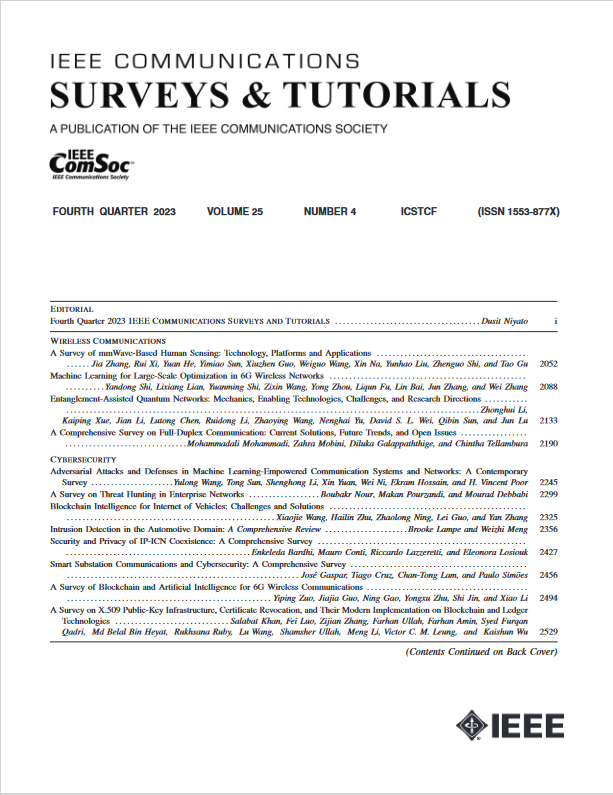天-空-地网络中用于动态管理和控制的平均场博弈研究
IF 34.4
1区 计算机科学
Q1 COMPUTER SCIENCE, INFORMATION SYSTEMS
引用次数: 0
摘要
第六代(6G)移动通信网络的数据流量巨大,各种通信服务和场景都面临着新的挑战。这就需要在地面和太空部署超密集的异构网络节点,形成超密集的空-空-地网络。然而,传统模型无法分析和设计异构网络节点之间的互动。博弈论可为分析和设计提供有效的数学建模框架。对于 6G 空间-空气-地面网络,随机、超密集和分布式控制的特点将使传统博弈论方法面临维数诅咒的挑战。平均场博弈(MFG)可用于解耦代理之间的动态管理和控制,解耦代理在高维系统中的相互作用。虽然平均场博弈(MFG)得到了广泛的应用,但目前还缺乏一份全面的调查报告来阐明其基本原理并总结平均场博弈(MFG)的研究现状。在本研究中,我们将对 MFG 的应用进行调查和概述。首先,我们讨论了各种 6G 天-空-地网络范例,然后介绍了 MFG 的基本概念。其次,我们研究并考察了各种基于 MFG 的优化控制策略以及均场均衡(MFE)解决方案。此外,我们还讨论了将 MFG 与其他博弈论方法和机器学习方法相结合的有效性,从而提高多代理系统的性能。最后,我们根据当前的技术水平概述了一些开放性问题、技术挑战和未来研究方向。本文章由计算机程序翻译,如有差异,请以英文原文为准。
A Survey on Mean-Field Game for Dynamic Management and Control in Space-Air-Ground Network
The data traffic volume of the 6th generation (6G) mobile communication networks is huge, and there are novel challenges in various communications services and scenarios. This calls for ultra-dense and heterogeneous deployments of network nodes both on the ground and in space, resulting in ultra-dense space-air-ground network. However, conventional models are not available to analyze and design the interactions among heterogeneous network nodes. Game theory can provide an effective mathematical modeling framework for analysis and design. For the 6G space-air-ground networks, the characteristics of stochastic, ultra-dense, and distributed control will cause conventional game theoretical approaches to confront the challenge of the curse of dimensionality. Mean-field game (MFG) can be introduced to decouple dynamic management and control among agents, to decouple their interactions in a high-dimensional regime. Although the MFG finds wide application, there lacks a comprehensive survey to clarify the basics and summarize the state of the art of MFG research status. In this survey, we investigate and provide an overview of the applications of the MFG. First, we discuss diverse 6G space-air-ground networking paradigms, and then introduce the basic concepts of the MFG. Second, various MFG-based optimal control policies together with mean-field equilibrium (MFE) solutions are investigated and surveyed. Moreover, we discuss the effectiveness of combining the MFG with other game-theoretic approaches and machine learning methods, which leads to the improvement of multi-agent system performances. Finally, we outline some open issues, technical challenges, and future research directions based on the current state of the art.
求助全文
通过发布文献求助,成功后即可免费获取论文全文。
去求助
来源期刊

IEEE Communications Surveys and Tutorials
COMPUTER SCIENCE, INFORMATION SYSTEMS-TELECOMMUNICATIONS
CiteScore
80.20
自引率
2.50%
发文量
84
审稿时长
6 months
期刊介绍:
IEEE Communications Surveys & Tutorials is an online journal published by the IEEE Communications Society for tutorials and surveys covering all aspects of the communications field. Telecommunications technology is progressing at a rapid pace, and the IEEE Communications Society is committed to providing researchers and other professionals the information and tools to stay abreast. IEEE Communications Surveys and Tutorials focuses on integrating and adding understanding to the existing literature on communications, putting results in context. Whether searching for in-depth information about a familiar area or an introduction into a new area, IEEE Communications Surveys & Tutorials aims to be the premier source of peer-reviewed, comprehensive tutorials and surveys, and pointers to further sources. IEEE Communications Surveys & Tutorials publishes only articles exclusively written for IEEE Communications Surveys & Tutorials and go through a rigorous review process before their publication in the quarterly issues.
A tutorial article in the IEEE Communications Surveys & Tutorials should be designed to help the reader to become familiar with and learn something specific about a chosen topic. In contrast, the term survey, as applied here, is defined to mean a survey of the literature. A survey article in IEEE Communications Surveys & Tutorials should provide a comprehensive review of developments in a selected area, covering its development from its inception to its current state and beyond, and illustrating its development through liberal citations from the literature. Both tutorials and surveys should be tutorial in nature and should be written in a style comprehensible to readers outside the specialty of the article.
 求助内容:
求助内容: 应助结果提醒方式:
应助结果提醒方式:


